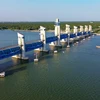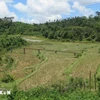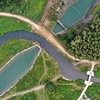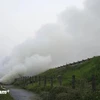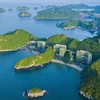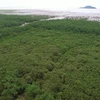The Prime Minister has approved a master plan on biodiversity conservation through 2020 with a vision towards 2030.
According to the Government Portal, the master plan aims to preserve and develop important natural ecosystems, valuable and endangered genetic sources. It will also maintain and strengthen ecosystem services in response to climate change in order to boost national sustainable development.
Under the plan, by 2020, biodiversity conservation will be carried out in eight geographical regions nationwide with four types of conservation, namely natural ecosystem, conservation area, biodiversity conservation centre and biodiversity corridor.
In the northeastern region, conservation activities cover natural forest ecosystems of Red River, Lo River and Gam River; the limestone ecosystems in Tuyen Quang, Ha Giang, Lang Son, Bac Kan, Cao Bang and Quang Ninh provinces, and the wetland ecosystems in Dam Ha and Yen Hung (Quang Ninh province).
Three biodiversity conservation centres on animals, plants and herbal gardens will be established.
A biodiversity conservation corridor with an area of around 506 hectares will be set up between Na Hang Nature Reserve and Ba Be National Park in Bac Kan province.
In the Red River delta, natural salt-tolerant forest ecosystems in Hai Phong and Thai Binh and important wetland ecosystems in Ninh Binh and Nam Dinh provinces will be preserved.
For south-central region, preservation will be carried out in the natural forest ecosystems in Cai River, Con River, Da Nang River, Ba River, Tra Khuc River and Thu Bon River; coral reef and sea-grass ecosystems in Cu lao Cham, Ninh Hai, Vinh Hy bay, Cam Ranh bay, Thuy Trien lagoon, Van Phong bay; and wetland ecosystems.
Under the master plan, 46 conservation areas will be established with a total area of 567,000 hectares in the 2016-2020 period.
By 2030, 20 other conservation areas will be established, raising the total number to 219 with the aggregate area of over 3 million hectares.-VNA
According to the Government Portal, the master plan aims to preserve and develop important natural ecosystems, valuable and endangered genetic sources. It will also maintain and strengthen ecosystem services in response to climate change in order to boost national sustainable development.
Under the plan, by 2020, biodiversity conservation will be carried out in eight geographical regions nationwide with four types of conservation, namely natural ecosystem, conservation area, biodiversity conservation centre and biodiversity corridor.
In the northeastern region, conservation activities cover natural forest ecosystems of Red River, Lo River and Gam River; the limestone ecosystems in Tuyen Quang, Ha Giang, Lang Son, Bac Kan, Cao Bang and Quang Ninh provinces, and the wetland ecosystems in Dam Ha and Yen Hung (Quang Ninh province).
Three biodiversity conservation centres on animals, plants and herbal gardens will be established.
A biodiversity conservation corridor with an area of around 506 hectares will be set up between Na Hang Nature Reserve and Ba Be National Park in Bac Kan province.
In the Red River delta, natural salt-tolerant forest ecosystems in Hai Phong and Thai Binh and important wetland ecosystems in Ninh Binh and Nam Dinh provinces will be preserved.
For south-central region, preservation will be carried out in the natural forest ecosystems in Cai River, Con River, Da Nang River, Ba River, Tra Khuc River and Thu Bon River; coral reef and sea-grass ecosystems in Cu lao Cham, Ninh Hai, Vinh Hy bay, Cam Ranh bay, Thuy Trien lagoon, Van Phong bay; and wetland ecosystems.
Under the master plan, 46 conservation areas will be established with a total area of 567,000 hectares in the 2016-2020 period.
By 2030, 20 other conservation areas will be established, raising the total number to 219 with the aggregate area of over 3 million hectares.-VNA

